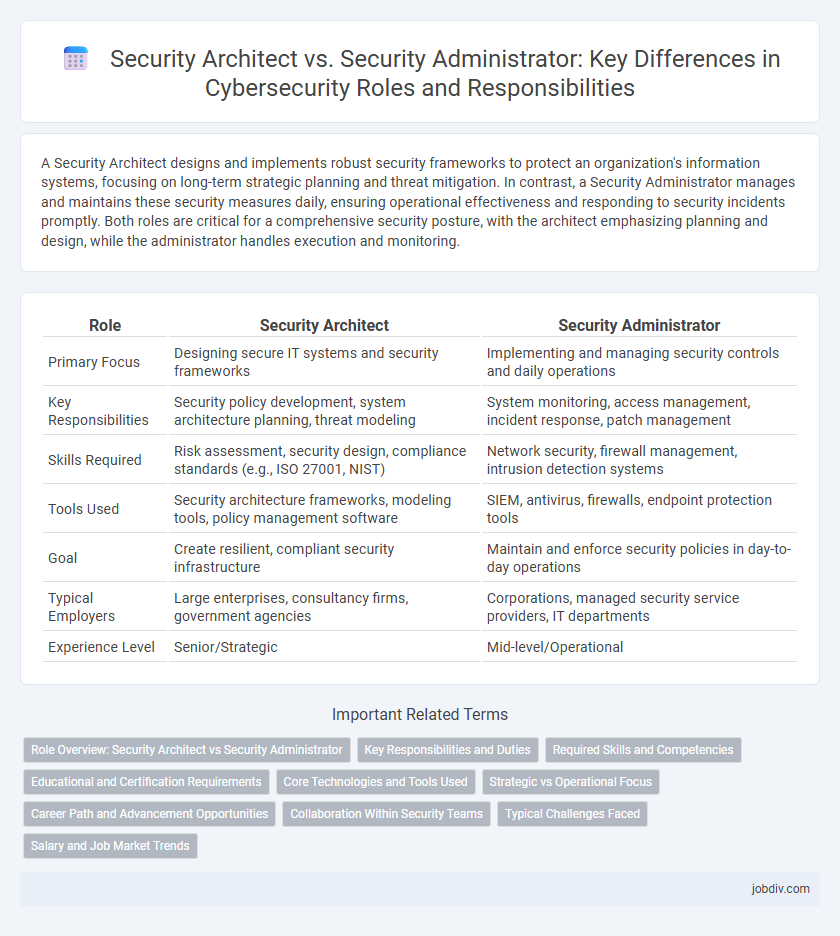A Security Architect designs and implements robust security frameworks to protect an organization's information systems, focusing on long-term strategic planning and threat mitigation. In contrast, a Security Administrator manages and maintains these security measures daily, ensuring operational effectiveness and responding to security incidents promptly. Both roles are critical for a comprehensive security posture, with the architect emphasizing planning and design, while the administrator handles execution and monitoring.
Table of Comparison
| Role | Security Architect | Security Administrator |
|---|---|---|
| Primary Focus | Designing secure IT systems and security frameworks | Implementing and managing security controls and daily operations |
| Key Responsibilities | Security policy development, system architecture planning, threat modeling | System monitoring, access management, incident response, patch management |
| Skills Required | Risk assessment, security design, compliance standards (e.g., ISO 27001, NIST) | Network security, firewall management, intrusion detection systems |
| Tools Used | Security architecture frameworks, modeling tools, policy management software | SIEM, antivirus, firewalls, endpoint protection tools |
| Goal | Create resilient, compliant security infrastructure | Maintain and enforce security policies in day-to-day operations |
| Typical Employers | Large enterprises, consultancy firms, government agencies | Corporations, managed security service providers, IT departments |
| Experience Level | Senior/Strategic | Mid-level/Operational |
Role Overview: Security Architect vs Security Administrator
A Security Architect designs and plans the overall cybersecurity infrastructure, focusing on creating secure systems and protocols to prevent breaches. In contrast, a Security Administrator manages and maintains these security systems daily, ensuring operational effectiveness and responding to incidents in real-time. The Security Architect drives strategic security initiatives, while the Security Administrator handles tactical implementation and monitoring.
Key Responsibilities and Duties
Security Architects design and implement comprehensive security structures, focusing on long-term strategies, threat modeling, and system integration to safeguard organizational assets. Security Administrators manage daily security operations, enforce access controls, monitor network activity, and respond to incidents to maintain system integrity. Both roles collaborate closely to ensure robust security frameworks and operational resilience.
Required Skills and Competencies
Security Architects require advanced skills in designing secure network frameworks, proficiency in risk assessment methodologies, and expertise in implementing robust security protocols aligned with organizational goals. Security Administrators need competencies in managing daily security operations, monitoring network traffic for threats, and executing incident response procedures with detailed knowledge of firewall configurations and access controls. Both roles demand strong analytical abilities, familiarity with compliance standards like ISO 27001, and continuous learning to address evolving cybersecurity threats.
Educational and Certification Requirements
A Security Architect typically requires advanced degrees in computer science, information technology, or cybersecurity, along with professional certifications such as CISSP (Certified Information Systems Security Professional) and SABSA Chartered Security Architect. Security Administrators often hold a bachelor's degree in information technology or related fields and pursue certifications like CompTIA Security+, Cisco CCNA Security, or Microsoft Certified: Security Administrator Associate. Both roles benefit from continuous education, but architects generally need deeper expertise in designing security frameworks, reflected in more advanced certification and education paths.
Core Technologies and Tools Used
Security Architects design and implement security frameworks using advanced technologies like firewalls, intrusion detection systems (IDS), and secure network architectures to establish robust defenses. Security Administrators manage and monitor these systems daily, utilizing tools such as security information and event management (SIEM) platforms, antivirus software, and access control mechanisms to maintain operational security. Both roles require expertise in encryption, identity and access management (IAM), and vulnerability assessment tools to protect organizational assets effectively.
Strategic vs Operational Focus
A Security Architect designs and implements comprehensive security frameworks aligned with an organization's long-term strategic goals, emphasizing risk assessment and future-proofing infrastructure. In contrast, a Security Administrator manages day-to-day operational security tasks, such as monitoring systems, enforcing policies, and responding to incidents to ensure continuous protection. The Architect's role centers on proactive planning and policy design, while the Administrator focuses on reactive implementation and maintenance.
Career Path and Advancement Opportunities
Security Architects design comprehensive cybersecurity frameworks, focusing on strategic planning and advanced threat mitigation, often advancing into senior leadership roles such as Chief Information Security Officer (CISO). Security Administrators handle day-to-day security operations, including monitoring systems and managing access controls, with career progression typically moving towards specialized roles like Security Analyst or Security Engineer. Understanding the distinct responsibilities and skill sets of each position is crucial for professionals aiming to align their career paths with long-term advancement in cybersecurity.
Collaboration Within Security Teams
Security Architects design comprehensive security frameworks and collaborate closely with Security Administrators to ensure these architectures are effectively implemented and maintained. Both roles engage in continuous communication to adapt security measures based on evolving threats and organizational needs. Effective collaboration within security teams enhances risk management, policy enforcement, and incident response capabilities across the organization.
Typical Challenges Faced
Security Architects face challenges in designing comprehensive security frameworks that adapt to evolving cyber threats and integrating new technologies without compromising system integrity. Security Administrators typically struggle with implementing and maintaining security policies, managing access controls, and swiftly responding to incidents while ensuring minimal disruption to business operations. Both roles require continuous education to keep pace with emerging vulnerabilities and regulatory compliance demands.
Salary and Job Market Trends
Security Architects typically command higher salaries than Security Administrators due to their strategic responsibilities in designing and implementing comprehensive security systems, with average salaries ranging from $120,000 to $160,000 annually compared to $70,000 to $100,000 for administrators. The job market trend shows increasing demand for Security Architects as organizations prioritize advanced cybersecurity frameworks, while Security Administrators remain essential for day-to-day security operations and compliance management. Emerging technologies like cloud security and zero trust architectures further drive the value and salary growth prospects for Security Architects in the evolving cybersecurity landscape.
Security Architect vs Security Administrator Infographic

 jobdiv.com
jobdiv.com